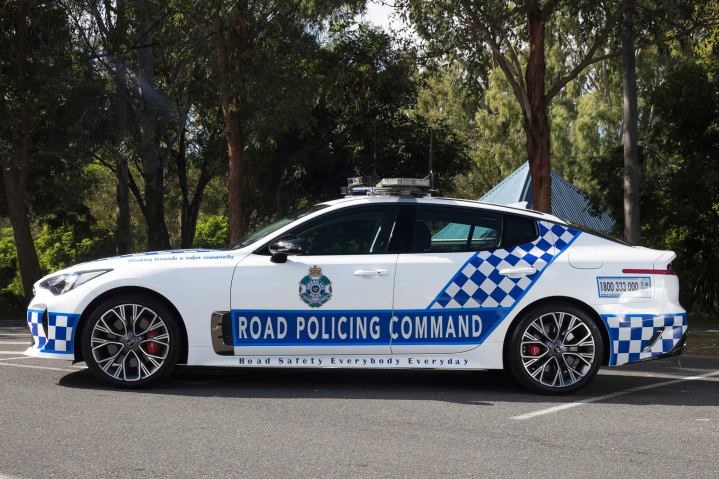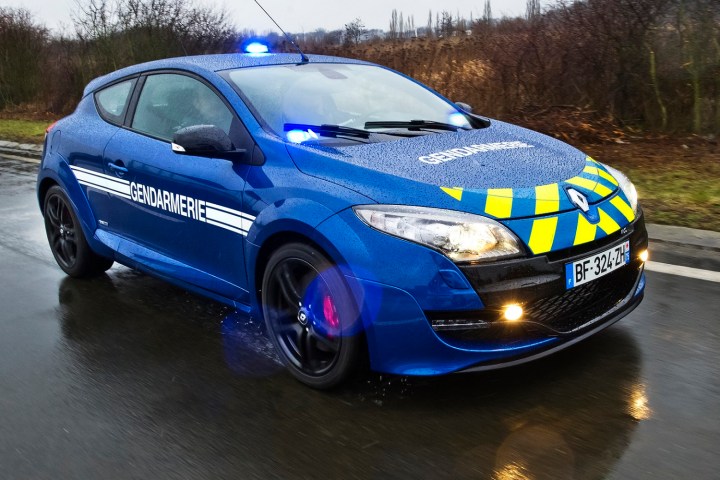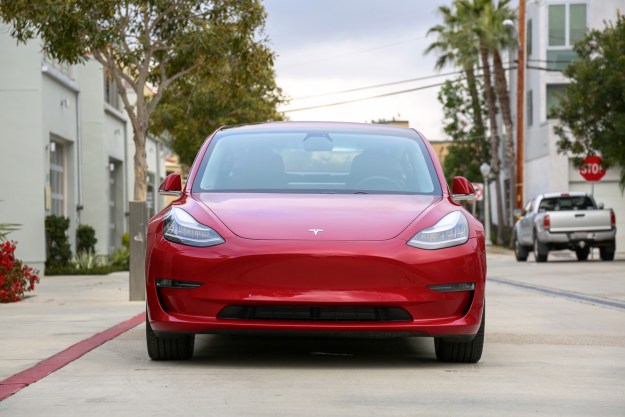Police departments save money by purchasing cars in bulk; it’s like going to Costco. This partially explains why the venerable Ford Crown Victoria faithfully served nearly every American law enforcement agency for decades. Cops sometimes think outside of the box, however, either because they need to — a Crown Vic won’t catch a Dodge Viper doing 140 miles per hour — or simply because they want to try something else.
Here are some of the most exotic, most expensive, most unexpected, and coolest police cars used around the world.
Australia: Kia Stinger GT

For decades, Australian police officers relied on V8-powered, rear-wheel drive Holden and Ford sedans to patrol the nation’s immense network of roads. These cars were powerful, comfortable, and well-suited to Australia’s unique landscape because they were designed and built locally. Production of the Ford Falcon and the Holden Commodore ended in 2017, however, leaving police officers without their go-to patrol car.
The state of Queensland purchased 50 examples of the Kia Stinger GT with a 3.3-liter, twin-turbocharged V6 engine to gradually replace the Falcons and Commodores. Representatives for the police force noted the Stinger GT is the first foreign patrol car the department has ever purchased.
Austria: Porsche 911

The Austrian police department received a 911 patrol car from Porsche in 2017. It was the latest in a long line of 911s used to catch drivers who speed across Austria. Before reporting for police duty, the coupe received the traditional blue and red livery worn by more down-to-earth Austrian police cars, an in-car radio system, and, of course, flashing blue lights. The police department has since returned the 911, but watch out if you’re planning on driving fast in Austria. We wouldn’t be surprised if the all-new 911 joins the Austrian fleet sooner or later.
Dubai: Exotics galore

The Dubai Police Force runs a fleet of exotic cars that wouldn’t look out of place in a rap video. The list includes an Aston-Martin One-77, a Bentley Bentayga, a BMW i8 (pictured), a Bugatti Veyron, a Ferrari LaFerrari, a Lamborghini Aventador, at least two McLarens, and even a Porsche 918 Spyder. Bugatti’s 1,500-horsepower Chiron isn’t part of the fleet… yet.
There’s a catch, though: They’re not all catching bad guys. Most of the high-horsepower police cars in the Dubai fleet are deployed in touristic areas, and they’re more show than go.
France: Renault Megane RS

The French Gendarmerie’s high-speed intervention unit operated a fleet of Renault Megane RS hot hatches for years. The Megane RS was up to the task of chasing speedsters at triple-digit speeds, because it boasted a turbocharged, 2.0-liter four-cylinder engine that delivered between 250 and 275 horsepower depending on the variant. It could reach a top speed of 158 mph.
In 2017, the Gendarmerie announced it would gradually retire its fleet of hot-rodded Meganes because they were simply too expensive to keep running. French police officers began using some of the high-performance cars seized from criminals to catch speeding motorists. They’re free, which is a huge plus.
Germany: Brabus CLS Rocket

In 2006, German authorities launched a program named Tune it Safe to raise awareness about the safe and legal ways to modify a car. World-famous Mercedes-Benz tuner Brabus helped promote the program and its message by turning a first-generation CLS into a hot rod in police livery. Called CLS Rocket, it received a 730-horsepower, twin-turbocharged V12 engine that sent it to a top speed of 225 mph. Sadly, only a single example was ever built.
Italy: Lamborghini Huracan

The Italian police force purchased a Lamborghini Huracan in 2017. It’s often sent to special events due to its photogenic design, but it’s also used to monitor the nation’s network of highways and catch up with German tourists who think they’re still on the unrestricted Autobahn. The Polizia outfitted its Huracan with an on-board tablet, video and audio recording equipment to document traffic stops, and a defibrillator. The front trunk — remember, the Huracan is mid-engined — is even refrigerated to carry organs.
The Huracan is undeniably one of the coolest patrol cars in the world. We’d recommend the Italian police upgrade to the Huracan Evo model, however, which is more high-tech and faster than its predecessor.
Japan: Nissan 370Z Nismo

Tokyo police acquired three Nissan 370Z Nismo coupes in 2016. They’re finished in a two-tone black and white livery, and they’ve traded their Nissan emblem for the Tokyo police’s insignia. All three cars are configured for patrol duty, and they’re certainly up to the task with 350 horsepower on tap, but they’re mostly used for promotional purposes within Tokyo city limits.
United Kingdom: Ariel Atom

If you get pulled over in Somerset County, England, there’s a chance you’ll hear the lights without seeing the vehicle they’re coming from in your rear-view mirror. After all, it’s too low.
In 2014, the Somerset County police department bought an Ariel Atom 3.5R and decked it out in full police livery, complete with pursuit lights and emergency equipment. The Atom is a 350-horsepower, 1,350-pound machine that blurs the line between a supercar and motorcycle. And, with a zero-to-60-mph time of 2.5 seconds, it can outrun almost anything on four wheels.
United States: Chevrolet Corvette Z06

The New Braunfels, Texas, police department ran a fleet of completely ordinary patrol cars until it seized a Chevrolet Corvette Z06 during a meth raid. It wasn’t a run-of-the-mill ‘Vette, either; it received a host of aftermarket modifications to bump its V8 engine’s output to 1,000 horsepower. Instead of selling the car, the police department wrapped it, fitted it with a light bar, and added it to its fleet.
The police force clarified it wasn’t planning on using the Corvette as a normal patrol car; it’s too high-profile to use as an undercover car, and too unpractical to use for traffic enforcement. Instead, it was used in parades and other community outreach events.
United States: Tesla Model S

The Fremont, California, police department will begin testing a Tesla Model S patrol car in 2019. Turning Tesla’s battery-electric sedan into a police cruiser is easier said than done, however. Standard equipment such as the light bar, the push bumper, and the prisoner partition need to be developed from scratch. The Model S is nearly ready to patrol the streets of Fremont, and the police department expects to save a substantial amount of money by going electric. If the sedan lives up to expectations, the department will purchase additional Tesla models to replace gasoline-powered patrol cars like the Dodge Charger.
Editors' Recommendations
- Dubai Police to deploy driverless patrol cars with AI smarts
- Tesla receives massive Model 3 order from car-rental giant Hertz
- Tesla gives the Model S over 1,000 hp and a spaceship-like steering wheel
- How to buy a Tesla online
- Tesla unveils $140,000 Model S Plaid that can go from 0 to 60 in under 2 seconds



